-
EXECUTIVE SUMMARY
-
Market Overview
-
Key Findings
-
Market Segmentation
-
Competitive Landscape
-
Challenges and Opportunities
-
Future Outlook
-
MARKET INTRODUCTION
-
Definition
-
Scope of the study
- Research Objective
- Assumption
- Limitations
-
RESEARCH METHODOLOGY
-
Overview
-
Data Mining
-
Secondary Research
-
Primary Research
- Primary Interviews and Information Gathering Process
- Breakdown of Primary Respondents
-
Forecasting Model
-
Market Size Estimation
- Bottom-Up Approach
- Top-Down Approach
-
Data Triangulation
-
Validation
-
MARKET DYNAMICS
-
Overview
-
Drivers
-
Restraints
-
Opportunities
-
MARKET FACTOR ANALYSIS
-
Value chain Analysis
-
Porter''s Five Forces Analysis
- Bargaining Power of Suppliers
- Bargaining Power of Buyers
- Threat of New Entrants
- Threat of Substitutes
- Intensity of Rivalry
-
COVID-19 Impact Analysis
- Market Impact Analysis
- Regional Impact
- Opportunity and Threat Analysis
-
UAV BATTERY MARKET, BY APPLICATION (USD BILLION)
-
Military
-
Commercial
-
Agricultural
-
Environmental Monitoring
-
UAV BATTERY MARKET, BY BATTERY TYPE (USD BILLION)
-
Lithium-Ion
-
Nickel-Cadmium
-
Lead Acid
-
Lithium Polymer
-
UAV BATTERY MARKET, BY VOLTAGE RANGE (USD BILLION)
-
Below 12V
-
12V to 24V
-
24V to 48V
-
Above 48V
-
UAV BATTERY MARKET, BY END USE (USD BILLION)
-
Private Use
-
Government Use
-
Industrial Use
-
UAV BATTERY MARKET, BY REGIONAL (USD BILLION)
-
North America
- US
- Canada
-
Europe
- Germany
- UK
- France
- Russia
- Italy
- Spain
- Rest of Europe
-
APAC
- China
- India
- Japan
- South Korea
- Malaysia
- Thailand
- Indonesia
- Rest of APAC
-
South America
- Brazil
- Mexico
- Argentina
- Rest of South America
-
MEA
- GCC Countries
- South Africa
- Rest of MEA
-
COMPETITIVE LANDSCAPE
-
Overview
-
Competitive Analysis
-
Market share Analysis
-
Major Growth Strategy in the UAV Battery Market
-
Competitive Benchmarking
-
Leading Players in Terms of Number of Developments in the UAV Battery Market
-
Key developments and growth strategies
- New Product Launch/Service Deployment
- Merger & Acquisitions
- Joint Ventures
-
Major Players Financial Matrix
- Sales and Operating Income
- Major Players R&D Expenditure. 2023
-
COMPANY PROFILES
-
Panasonic
- Financial Overview
- Products Offered
- Key Developments
- SWOT Analysis
- Key Strategies
-
Green Cubes Technology
- Financial Overview
- Products Offered
- Key Developments
- SWOT Analysis
- Key Strategies
-
VARTA AG
- Financial Overview
- Products Offered
- Key Developments
- SWOT Analysis
- Key Strategies
-
Sierra Energy
- Financial Overview
- Products Offered
- Key Developments
- SWOT Analysis
- Key Strategies
-
Maxwell Technologies
- Financial Overview
- Products Offered
- Key Developments
- SWOT Analysis
- Key Strategies
-
Lithion Energy
- Financial Overview
- Products Offered
- Key Developments
- SWOT Analysis
- Key Strategies
-
Exide Technologies
- Financial Overview
- Products Offered
- Key Developments
- SWOT Analysis
- Key Strategies
-
A123 Systems
- Financial Overview
- Products Offered
- Key Developments
- SWOT Analysis
- Key Strategies
-
Valence Technology
- Financial Overview
- Products Offered
- Key Developments
- SWOT Analysis
- Key Strategies
-
Molicel
- Financial Overview
- Products Offered
- Key Developments
- SWOT Analysis
- Key Strategies
-
Saft Batteries
- Financial Overview
- Products Offered
- Key Developments
- SWOT Analysis
- Key Strategies
-
Samsung SDI
- Financial Overview
- Products Offered
- Key Developments
- SWOT Analysis
- Key Strategies
-
EnerSys
- Financial Overview
- Products Offered
- Key Developments
- SWOT Analysis
- Key Strategies
-
LG Chem
- Financial Overview
- Products Offered
- Key Developments
- SWOT Analysis
- Key Strategies
-
Sony
- Financial Overview
- Products Offered
- Key Developments
- SWOT Analysis
- Key Strategies
-
APPENDIX
-
References
-
Related Reports
-
LIST OF TABLES
-
LIST OF ASSUMPTIONS
-
NORTH AMERICA UAV BATTERY MARKET SIZE ESTIMATES & FORECAST, BY APPLICATION, 2019-2035 (USD BILLIONS)
-
NORTH AMERICA UAV BATTERY MARKET SIZE ESTIMATES & FORECAST, BY BATTERY TYPE, 2019-2035 (USD BILLIONS)
-
NORTH AMERICA UAV BATTERY MARKET SIZE ESTIMATES & FORECAST, BY VOLTAGE RANGE, 2019-2035 (USD BILLIONS)
-
NORTH AMERICA UAV BATTERY MARKET SIZE ESTIMATES & FORECAST, BY END USE, 2019-2035 (USD BILLIONS)
-
NORTH AMERICA UAV BATTERY MARKET SIZE ESTIMATES & FORECAST, BY REGIONAL, 2019-2035 (USD BILLIONS)
-
US UAV BATTERY MARKET SIZE ESTIMATES & FORECAST, BY APPLICATION, 2019-2035 (USD BILLIONS)
-
US UAV BATTERY MARKET SIZE ESTIMATES & FORECAST, BY BATTERY TYPE, 2019-2035 (USD BILLIONS)
-
US UAV BATTERY MARKET SIZE ESTIMATES & FORECAST, BY VOLTAGE RANGE, 2019-2035 (USD BILLIONS)
-
US UAV BATTERY MARKET SIZE ESTIMATES & FORECAST, BY END USE, 2019-2035 (USD BILLIONS)
-
US UAV BATTERY MARKET SIZE ESTIMATES & FORECAST, BY REGIONAL, 2019-2035 (USD BILLIONS)
-
CANADA UAV BATTERY MARKET SIZE ESTIMATES & FORECAST, BY APPLICATION, 2019-2035 (USD BILLIONS)
-
CANADA UAV BATTERY MARKET SIZE ESTIMATES & FORECAST, BY BATTERY TYPE, 2019-2035 (USD BILLIONS)
-
CANADA UAV BATTERY MARKET SIZE ESTIMATES & FORECAST, BY VOLTAGE RANGE, 2019-2035 (USD BILLIONS)
-
CANADA UAV BATTERY MARKET SIZE ESTIMATES & FORECAST, BY END USE, 2019-2035 (USD BILLIONS)
-
CANADA UAV BATTERY MARKET SIZE ESTIMATES & FORECAST, BY REGIONAL, 2019-2035 (USD BILLIONS)
-
EUROPE UAV BATTERY MARKET SIZE ESTIMATES & FORECAST, BY APPLICATION, 2019-2035 (USD BILLIONS)
-
EUROPE UAV BATTERY MARKET SIZE ESTIMATES & FORECAST, BY BATTERY TYPE, 2019-2035 (USD BILLIONS)
-
EUROPE UAV BATTERY MARKET SIZE ESTIMATES & FORECAST, BY VOLTAGE RANGE, 2019-2035 (USD BILLIONS)
-
EUROPE UAV BATTERY MARKET SIZE ESTIMATES & FORECAST, BY END USE, 2019-2035 (USD BILLIONS)
-
EUROPE UAV BATTERY MARKET SIZE ESTIMATES & FORECAST, BY REGIONAL, 2019-2035 (USD BILLIONS)
-
GERMANY UAV BATTERY MARKET SIZE ESTIMATES & FORECAST, BY APPLICATION, 2019-2035 (USD BILLIONS)
-
GERMANY UAV BATTERY MARKET SIZE ESTIMATES & FORECAST, BY BATTERY TYPE, 2019-2035 (USD BILLIONS)
-
GERMANY UAV BATTERY MARKET SIZE ESTIMATES & FORECAST, BY VOLTAGE RANGE, 2019-2035 (USD BILLIONS)
-
GERMANY UAV BATTERY MARKET SIZE ESTIMATES & FORECAST, BY END USE, 2019-2035 (USD BILLIONS)
-
GERMANY UAV BATTERY MARKET SIZE ESTIMATES & FORECAST, BY REGIONAL, 2019-2035 (USD BILLIONS)
-
UK UAV BATTERY MARKET SIZE ESTIMATES & FORECAST, BY APPLICATION, 2019-2035 (USD BILLIONS)
-
UK UAV BATTERY MARKET SIZE ESTIMATES & FORECAST, BY BATTERY TYPE, 2019-2035 (USD BILLIONS)
-
UK UAV BATTERY MARKET SIZE ESTIMATES & FORECAST, BY VOLTAGE RANGE, 2019-2035 (USD BILLIONS)
-
UK UAV BATTERY MARKET SIZE ESTIMATES & FORECAST, BY END USE, 2019-2035 (USD BILLIONS)
-
UK UAV BATTERY MARKET SIZE ESTIMATES & FORECAST, BY REGIONAL, 2019-2035 (USD BILLIONS)
-
FRANCE UAV BATTERY MARKET SIZE ESTIMATES & FORECAST, BY APPLICATION, 2019-2035 (USD BILLIONS)
-
FRANCE UAV BATTERY MARKET SIZE ESTIMATES & FORECAST, BY BATTERY TYPE, 2019-2035 (USD BILLIONS)
-
FRANCE UAV BATTERY MARKET SIZE ESTIMATES & FORECAST, BY VOLTAGE RANGE, 2019-2035 (USD BILLIONS)
-
FRANCE UAV BATTERY MARKET SIZE ESTIMATES & FORECAST, BY END USE, 2019-2035 (USD BILLIONS)
-
FRANCE UAV BATTERY MARKET SIZE ESTIMATES & FORECAST, BY REGIONAL, 2019-2035 (USD BILLIONS)
-
RUSSIA UAV BATTERY MARKET SIZE ESTIMATES & FORECAST, BY APPLICATION, 2019-2035 (USD BILLIONS)
-
RUSSIA UAV BATTERY MARKET SIZE ESTIMATES & FORECAST, BY BATTERY TYPE, 2019-2035 (USD BILLIONS)
-
RUSSIA UAV BATTERY MARKET SIZE ESTIMATES & FORECAST, BY VOLTAGE RANGE, 2019-2035 (USD BILLIONS)
-
RUSSIA UAV BATTERY MARKET SIZE ESTIMATES & FORECAST, BY END USE, 2019-2035 (USD BILLIONS)
-
RUSSIA UAV BATTERY MARKET SIZE ESTIMATES & FORECAST, BY REGIONAL, 2019-2035 (USD BILLIONS)
-
ITALY UAV BATTERY MARKET SIZE ESTIMATES & FORECAST, BY APPLICATION, 2019-2035 (USD BILLIONS)
-
ITALY UAV BATTERY MARKET SIZE ESTIMATES & FORECAST, BY BATTERY TYPE, 2019-2035 (USD BILLIONS)
-
ITALY UAV BATTERY MARKET SIZE ESTIMATES & FORECAST, BY VOLTAGE RANGE, 2019-2035 (USD BILLIONS)
-
ITALY UAV BATTERY MARKET SIZE ESTIMATES & FORECAST, BY END USE, 2019-2035 (USD BILLIONS)
-
ITALY UAV BATTERY MARKET SIZE ESTIMATES & FORECAST, BY REGIONAL, 2019-2035 (USD BILLIONS)
-
SPAIN UAV BATTERY MARKET SIZE ESTIMATES & FORECAST, BY APPLICATION, 2019-2035 (USD BILLIONS)
-
SPAIN UAV BATTERY MARKET SIZE ESTIMATES & FORECAST, BY BATTERY TYPE, 2019-2035 (USD BILLIONS)
-
SPAIN UAV BATTERY MARKET SIZE ESTIMATES & FORECAST, BY VOLTAGE RANGE, 2019-2035 (USD BILLIONS)
-
SPAIN UAV BATTERY MARKET SIZE ESTIMATES & FORECAST, BY END USE, 2019-2035 (USD BILLIONS)
-
SPAIN UAV BATTERY MARKET SIZE ESTIMATES & FORECAST, BY REGIONAL, 2019-2035 (USD BILLIONS)
-
REST OF EUROPE UAV BATTERY MARKET SIZE ESTIMATES & FORECAST, BY APPLICATION, 2019-2035 (USD BILLIONS)
-
REST OF EUROPE UAV BATTERY MARKET SIZE ESTIMATES & FORECAST, BY BATTERY TYPE, 2019-2035 (USD BILLIONS)
-
REST OF EUROPE UAV BATTERY MARKET SIZE ESTIMATES & FORECAST, BY VOLTAGE RANGE, 2019-2035 (USD BILLIONS)
-
REST OF EUROPE UAV BATTERY MARKET SIZE ESTIMATES & FORECAST, BY END USE, 2019-2035 (USD BILLIONS)
-
REST OF EUROPE UAV BATTERY MARKET SIZE ESTIMATES & FORECAST, BY REGIONAL, 2019-2035 (USD BILLIONS)
-
APAC UAV BATTERY MARKET SIZE ESTIMATES & FORECAST, BY APPLICATION, 2019-2035 (USD BILLIONS)
-
APAC UAV BATTERY MARKET SIZE ESTIMATES & FORECAST, BY BATTERY TYPE, 2019-2035 (USD BILLIONS)
-
APAC UAV BATTERY MARKET SIZE ESTIMATES & FORECAST, BY VOLTAGE RANGE, 2019-2035 (USD BILLIONS)
-
APAC UAV BATTERY MARKET SIZE ESTIMATES & FORECAST, BY END USE, 2019-2035 (USD BILLIONS)
-
APAC UAV BATTERY MARKET SIZE ESTIMATES & FORECAST, BY REGIONAL, 2019-2035 (USD BILLIONS)
-
CHINA UAV BATTERY MARKET SIZE ESTIMATES & FORECAST, BY APPLICATION, 2019-2035 (USD BILLIONS)
-
CHINA UAV BATTERY MARKET SIZE ESTIMATES & FORECAST, BY BATTERY TYPE, 2019-2035 (USD BILLIONS)
-
CHINA UAV BATTERY MARKET SIZE ESTIMATES & FORECAST, BY VOLTAGE RANGE, 2019-2035 (USD BILLIONS)
-
CHINA UAV BATTERY MARKET SIZE ESTIMATES & FORECAST, BY END USE, 2019-2035 (USD BILLIONS)
-
CHINA UAV BATTERY MARKET SIZE ESTIMATES & FORECAST, BY REGIONAL, 2019-2035 (USD BILLIONS)
-
INDIA UAV BATTERY MARKET SIZE ESTIMATES & FORECAST, BY APPLICATION, 2019-2035 (USD BILLIONS)
-
INDIA UAV BATTERY MARKET SIZE ESTIMATES & FORECAST, BY BATTERY TYPE, 2019-2035 (USD BILLIONS)
-
INDIA UAV BATTERY MARKET SIZE ESTIMATES & FORECAST, BY VOLTAGE RANGE, 2019-2035 (USD BILLIONS)
-
INDIA UAV BATTERY MARKET SIZE ESTIMATES & FORECAST, BY END USE, 2019-2035 (USD BILLIONS)
-
INDIA UAV BATTERY MARKET SIZE ESTIMATES & FORECAST, BY REGIONAL, 2019-2035 (USD BILLIONS)
-
JAPAN UAV BATTERY MARKET SIZE ESTIMATES & FORECAST, BY APPLICATION, 2019-2035 (USD BILLIONS)
-
JAPAN UAV BATTERY MARKET SIZE ESTIMATES & FORECAST, BY BATTERY TYPE, 2019-2035 (USD BILLIONS)
-
JAPAN UAV BATTERY MARKET SIZE ESTIMATES & FORECAST, BY VOLTAGE RANGE, 2019-2035 (USD BILLIONS)
-
JAPAN UAV BATTERY MARKET SIZE ESTIMATES & FORECAST, BY END USE, 2019-2035 (USD BILLIONS)
-
JAPAN UAV BATTERY MARKET SIZE ESTIMATES & FORECAST, BY REGIONAL, 2019-2035 (USD BILLIONS)
-
SOUTH KOREA UAV BATTERY MARKET SIZE ESTIMATES & FORECAST, BY APPLICATION, 2019-2035 (USD BILLIONS)
-
SOUTH KOREA UAV BATTERY MARKET SIZE ESTIMATES & FORECAST, BY BATTERY TYPE, 2019-2035 (USD BILLIONS)
-
SOUTH KOREA UAV BATTERY MARKET SIZE ESTIMATES & FORECAST, BY VOLTAGE RANGE, 2019-2035 (USD BILLIONS)
-
SOUTH KOREA UAV BATTERY MARKET SIZE ESTIMATES & FORECAST, BY END USE, 2019-2035 (USD BILLIONS)
-
SOUTH KOREA UAV BATTERY MARKET SIZE ESTIMATES & FORECAST, BY REGIONAL, 2019-2035 (USD BILLIONS)
-
MALAYSIA UAV BATTERY MARKET SIZE ESTIMATES & FORECAST, BY APPLICATION, 2019-2035 (USD BILLIONS)
-
MALAYSIA UAV BATTERY MARKET SIZE ESTIMATES & FORECAST, BY BATTERY TYPE, 2019-2035 (USD BILLIONS)
-
MALAYSIA UAV BATTERY MARKET SIZE ESTIMATES & FORECAST, BY VOLTAGE RANGE, 2019-2035 (USD BILLIONS)
-
MALAYSIA UAV BATTERY MARKET SIZE ESTIMATES & FORECAST, BY END USE, 2019-2035 (USD BILLIONS)
-
MALAYSIA UAV BATTERY MARKET SIZE ESTIMATES & FORECAST, BY REGIONAL, 2019-2035 (USD BILLIONS)
-
THAILAND UAV BATTERY MARKET SIZE ESTIMATES & FORECAST, BY APPLICATION, 2019-2035 (USD BILLIONS)
-
THAILAND UAV BATTERY MARKET SIZE ESTIMATES & FORECAST, BY BATTERY TYPE, 2019-2035 (USD BILLIONS)
-
THAILAND UAV BATTERY MARKET SIZE ESTIMATES & FORECAST, BY VOLTAGE RANGE, 2019-2035 (USD BILLIONS)
-
THAILAND UAV BATTERY MARKET SIZE ESTIMATES & FORECAST, BY END USE, 2019-2035 (USD BILLIONS)
-
THAILAND UAV BATTERY MARKET SIZE ESTIMATES & FORECAST, BY REGIONAL, 2019-2035 (USD BILLIONS)
-
INDONESIA UAV BATTERY MARKET SIZE ESTIMATES & FORECAST, BY APPLICATION, 2019-2035 (USD BILLIONS)
-
INDONESIA UAV BATTERY MARKET SIZE ESTIMATES & FORECAST, BY BATTERY TYPE, 2019-2035 (USD BILLIONS)
-
INDONESIA UAV BATTERY MARKET SIZE ESTIMATES & FORECAST, BY VOLTAGE RANGE, 2019-2035 (USD BILLIONS)
-
INDONESIA UAV BATTERY MARKET SIZE ESTIMATES & FORECAST, BY END USE, 2019-2035 (USD BILLIONS)
-
INDONESIA UAV BATTERY MARKET SIZE ESTIMATES & FORECAST, BY REGIONAL, 2019-2035 (USD BILLIONS)
-
REST OF APAC UAV BATTERY MARKET SIZE ESTIMATES & FORECAST, BY APPLICATION, 2019-2035 (USD BILLIONS)
-
REST OF APAC UAV BATTERY MARKET SIZE ESTIMATES & FORECAST, BY BATTERY TYPE, 2019-2035 (USD BILLIONS)
-
REST OF APAC UAV BATTERY MARKET SIZE ESTIMATES & FORECAST, BY VOLTAGE RANGE, 2019-2035 (USD BILLIONS)
-
REST OF APAC UAV BATTERY MARKET SIZE ESTIMATES & FORECAST, BY END USE, 2019-2035 (USD BILLIONS)
-
REST OF APAC UAV BATTERY MARKET SIZE ESTIMATES & FORECAST, BY REGIONAL, 2019-2035 (USD BILLIONS)
-
SOUTH AMERICA UAV BATTERY MARKET SIZE ESTIMATES & FORECAST, BY APPLICATION, 2019-2035 (USD BILLIONS)
-
SOUTH AMERICA UAV BATTERY MARKET SIZE ESTIMATES & FORECAST, BY BATTERY TYPE, 2019-2035 (USD BILLIONS)
-
SOUTH AMERICA UAV BATTERY MARKET SIZE ESTIMATES & FORECAST, BY VOLTAGE RANGE, 2019-2035 (USD BILLIONS)
-
SOUTH AMERICA UAV BATTERY MARKET SIZE ESTIMATES & FORECAST, BY END USE, 2019-2035 (USD BILLIONS)
-
SOUTH AMERICA UAV BATTERY MARKET SIZE ESTIMATES & FORECAST, BY REGIONAL, 2019-2035 (USD BILLIONS)
-
BRAZIL UAV BATTERY MARKET SIZE ESTIMATES & FORECAST, BY APPLICATION, 2019-2035 (USD BILLIONS)
-
BRAZIL UAV BATTERY MARKET SIZE ESTIMATES & FORECAST, BY BATTERY TYPE, 2019-2035 (USD BILLIONS)
-
BRAZIL UAV BATTERY MARKET SIZE ESTIMATES & FORECAST, BY VOLTAGE RANGE, 2019-2035 (USD BILLIONS)
-
BRAZIL UAV BATTERY MARKET SIZE ESTIMATES & FORECAST, BY END USE, 2019-2035 (USD BILLIONS)
-
BRAZIL UAV BATTERY MARKET SIZE ESTIMATES & FORECAST, BY REGIONAL, 2019-2035 (USD BILLIONS)
-
MEXICO UAV BATTERY MARKET SIZE ESTIMATES & FORECAST, BY APPLICATION, 2019-2035 (USD BILLIONS)
-
MEXICO UAV BATTERY MARKET SIZE ESTIMATES & FORECAST, BY BATTERY TYPE, 2019-2035 (USD BILLIONS)
-
MEXICO UAV BATTERY MARKET SIZE ESTIMATES & FORECAST, BY VOLTAGE RANGE, 2019-2035 (USD BILLIONS)
-
MEXICO UAV BATTERY MARKET SIZE ESTIMATES & FORECAST, BY END USE, 2019-2035 (USD BILLIONS)
-
MEXICO UAV BATTERY MARKET SIZE ESTIMATES & FORECAST, BY REGIONAL, 2019-2035 (USD BILLIONS)
-
ARGENTINA UAV BATTERY MARKET SIZE ESTIMATES & FORECAST, BY APPLICATION, 2019-2035 (USD BILLIONS)
-
ARGENTINA UAV BATTERY MARKET SIZE ESTIMATES & FORECAST, BY BATTERY TYPE, 2019-2035 (USD BILLIONS)
-
ARGENTINA UAV BATTERY MARKET SIZE ESTIMATES & FORECAST, BY VOLTAGE RANGE, 2019-2035 (USD BILLIONS)
-
ARGENTINA UAV BATTERY MARKET SIZE ESTIMATES & FORECAST, BY END USE, 2019-2035 (USD BILLIONS)
-
ARGENTINA UAV BATTERY MARKET SIZE ESTIMATES & FORECAST, BY REGIONAL, 2019-2035 (USD BILLIONS)
-
REST OF SOUTH AMERICA UAV BATTERY MARKET SIZE ESTIMATES & FORECAST, BY APPLICATION, 2019-2035 (USD BILLIONS)
-
REST OF SOUTH AMERICA UAV BATTERY MARKET SIZE ESTIMATES & FORECAST, BY BATTERY TYPE, 2019-2035 (USD BILLIONS)
-
REST OF SOUTH AMERICA UAV BATTERY MARKET SIZE ESTIMATES & FORECAST, BY VOLTAGE RANGE, 2019-2035 (USD BILLIONS)
-
REST OF SOUTH AMERICA UAV BATTERY MARKET SIZE ESTIMATES & FORECAST, BY END USE, 2019-2035 (USD BILLIONS)
-
REST OF SOUTH AMERICA UAV BATTERY MARKET SIZE ESTIMATES & FORECAST, BY REGIONAL, 2019-2035 (USD BILLIONS)
-
MEA UAV BATTERY MARKET SIZE ESTIMATES & FORECAST, BY APPLICATION, 2019-2035 (USD BILLIONS)
-
MEA UAV BATTERY MARKET SIZE ESTIMATES & FORECAST, BY BATTERY TYPE, 2019-2035 (USD BILLIONS)
-
MEA UAV BATTERY MARKET SIZE ESTIMATES & FORECAST, BY VOLTAGE RANGE, 2019-2035 (USD BILLIONS)
-
MEA UAV BATTERY MARKET SIZE ESTIMATES & FORECAST, BY END USE, 2019-2035 (USD BILLIONS)
-
MEA UAV BATTERY MARKET SIZE ESTIMATES & FORECAST, BY REGIONAL, 2019-2035 (USD BILLIONS)
-
GCC COUNTRIES UAV BATTERY MARKET SIZE ESTIMATES & FORECAST, BY APPLICATION, 2019-2035 (USD BILLIONS)
-
GCC COUNTRIES UAV BATTERY MARKET SIZE ESTIMATES & FORECAST, BY BATTERY TYPE, 2019-2035 (USD BILLIONS)
-
GCC COUNTRIES UAV BATTERY MARKET SIZE ESTIMATES & FORECAST, BY VOLTAGE RANGE, 2019-2035 (USD BILLIONS)
-
GCC COUNTRIES UAV BATTERY MARKET SIZE ESTIMATES & FORECAST, BY END USE, 2019-2035 (USD BILLIONS)
-
GCC COUNTRIES UAV BATTERY MARKET SIZE ESTIMATES & FORECAST, BY REGIONAL, 2019-2035 (USD BILLIONS)
-
SOUTH AFRICA UAV BATTERY MARKET SIZE ESTIMATES & FORECAST, BY APPLICATION, 2019-2035 (USD BILLIONS)
-
SOUTH AFRICA UAV BATTERY MARKET SIZE ESTIMATES & FORECAST, BY BATTERY TYPE, 2019-2035 (USD BILLIONS)
-
SOUTH AFRICA UAV BATTERY MARKET SIZE ESTIMATES & FORECAST, BY VOLTAGE RANGE, 2019-2035 (USD BILLIONS)
-
SOUTH AFRICA UAV BATTERY MARKET SIZE ESTIMATES & FORECAST, BY END USE, 2019-2035 (USD BILLIONS)
-
SOUTH AFRICA UAV BATTERY MARKET SIZE ESTIMATES & FORECAST, BY REGIONAL, 2019-2035 (USD BILLIONS)
-
REST OF MEA UAV BATTERY MARKET SIZE ESTIMATES & FORECAST, BY APPLICATION, 2019-2035 (USD BILLIONS)
-
REST OF MEA UAV BATTERY MARKET SIZE ESTIMATES & FORECAST, BY BATTERY TYPE, 2019-2035 (USD BILLIONS)
-
REST OF MEA UAV BATTERY MARKET SIZE ESTIMATES & FORECAST, BY VOLTAGE RANGE, 2019-2035 (USD BILLIONS)
-
REST OF MEA UAV BATTERY MARKET SIZE ESTIMATES & FORECAST, BY END USE, 2019-2035 (USD BILLIONS)
-
REST OF MEA UAV BATTERY MARKET SIZE ESTIMATES & FORECAST, BY REGIONAL, 2019-2035 (USD BILLIONS)
-
PRODUCT LAUNCH/PRODUCT DEVELOPMENT/APPROVAL
-
ACQUISITION/PARTNERSHIP
-
LIST OF FIGURES
-
MARKET SYNOPSIS
-
NORTH AMERICA UAV BATTERY MARKET ANALYSIS
-
US UAV BATTERY MARKET ANALYSIS BY APPLICATION
-
US UAV BATTERY MARKET ANALYSIS BY BATTERY TYPE
-
US UAV BATTERY MARKET ANALYSIS BY VOLTAGE RANGE
-
US UAV BATTERY MARKET ANALYSIS BY END USE
-
US UAV BATTERY MARKET ANALYSIS BY REGIONAL
-
CANADA UAV BATTERY MARKET ANALYSIS BY APPLICATION
-
CANADA UAV BATTERY MARKET ANALYSIS BY BATTERY TYPE
-
CANADA UAV BATTERY MARKET ANALYSIS BY VOLTAGE RANGE
-
CANADA UAV BATTERY MARKET ANALYSIS BY END USE
-
CANADA UAV BATTERY MARKET ANALYSIS BY REGIONAL
-
EUROPE UAV BATTERY MARKET ANALYSIS
-
GERMANY UAV BATTERY MARKET ANALYSIS BY APPLICATION
-
GERMANY UAV BATTERY MARKET ANALYSIS BY BATTERY TYPE
-
GERMANY UAV BATTERY MARKET ANALYSIS BY VOLTAGE RANGE
-
GERMANY UAV BATTERY MARKET ANALYSIS BY END USE
-
GERMANY UAV BATTERY MARKET ANALYSIS BY REGIONAL
-
UK UAV BATTERY MARKET ANALYSIS BY APPLICATION
-
UK UAV BATTERY MARKET ANALYSIS BY BATTERY TYPE
-
UK UAV BATTERY MARKET ANALYSIS BY VOLTAGE RANGE
-
UK UAV BATTERY MARKET ANALYSIS BY END USE
-
UK UAV BATTERY MARKET ANALYSIS BY REGIONAL
-
FRANCE UAV BATTERY MARKET ANALYSIS BY APPLICATION
-
FRANCE UAV BATTERY MARKET ANALYSIS BY BATTERY TYPE
-
FRANCE UAV BATTERY MARKET ANALYSIS BY VOLTAGE RANGE
-
FRANCE UAV BATTERY MARKET ANALYSIS BY END USE
-
FRANCE UAV BATTERY MARKET ANALYSIS BY REGIONAL
-
RUSSIA UAV BATTERY MARKET ANALYSIS BY APPLICATION
-
RUSSIA UAV BATTERY MARKET ANALYSIS BY BATTERY TYPE
-
RUSSIA UAV BATTERY MARKET ANALYSIS BY VOLTAGE RANGE
-
RUSSIA UAV BATTERY MARKET ANALYSIS BY END USE
-
RUSSIA UAV BATTERY MARKET ANALYSIS BY REGIONAL
-
ITALY UAV BATTERY MARKET ANALYSIS BY APPLICATION
-
ITALY UAV BATTERY MARKET ANALYSIS BY BATTERY TYPE
-
ITALY UAV BATTERY MARKET ANALYSIS BY VOLTAGE RANGE
-
ITALY UAV BATTERY MARKET ANALYSIS BY END USE
-
ITALY UAV BATTERY MARKET ANALYSIS BY REGIONAL
-
SPAIN UAV BATTERY MARKET ANALYSIS BY APPLICATION
-
SPAIN UAV BATTERY MARKET ANALYSIS BY BATTERY TYPE
-
SPAIN UAV BATTERY MARKET ANALYSIS BY VOLTAGE RANGE
-
SPAIN UAV BATTERY MARKET ANALYSIS BY END USE
-
SPAIN UAV BATTERY MARKET ANALYSIS BY REGIONAL
-
REST OF EUROPE UAV BATTERY MARKET ANALYSIS BY APPLICATION
-
REST OF EUROPE UAV BATTERY MARKET ANALYSIS BY BATTERY TYPE
-
REST OF EUROPE UAV BATTERY MARKET ANALYSIS BY VOLTAGE RANGE
-
REST OF EUROPE UAV BATTERY MARKET ANALYSIS BY END USE
-
REST OF EUROPE UAV BATTERY MARKET ANALYSIS BY REGIONAL
-
APAC UAV BATTERY MARKET ANALYSIS
-
CHINA UAV BATTERY MARKET ANALYSIS BY APPLICATION
-
CHINA UAV BATTERY MARKET ANALYSIS BY BATTERY TYPE
-
CHINA UAV BATTERY MARKET ANALYSIS BY VOLTAGE RANGE
-
CHINA UAV BATTERY MARKET ANALYSIS BY END USE
-
CHINA UAV BATTERY MARKET ANALYSIS BY REGIONAL
-
INDIA UAV BATTERY MARKET ANALYSIS BY APPLICATION
-
INDIA UAV BATTERY MARKET ANALYSIS BY BATTERY TYPE
-
INDIA UAV BATTERY MARKET ANALYSIS BY VOLTAGE RANGE
-
INDIA UAV BATTERY MARKET ANALYSIS BY END USE
-
INDIA UAV BATTERY MARKET ANALYSIS BY REGIONAL
-
JAPAN UAV BATTERY MARKET ANALYSIS BY APPLICATION
-
JAPAN UAV BATTERY MARKET ANALYSIS BY BATTERY TYPE
-
JAPAN UAV BATTERY MARKET ANALYSIS BY VOLTAGE RANGE
-
JAPAN UAV BATTERY MARKET ANALYSIS BY END USE
-
JAPAN UAV BATTERY MARKET ANALYSIS BY REGIONAL
-
SOUTH KOREA UAV BATTERY MARKET ANALYSIS BY APPLICATION
-
SOUTH KOREA UAV BATTERY MARKET ANALYSIS BY BATTERY TYPE
-
SOUTH KOREA UAV BATTERY MARKET ANALYSIS BY VOLTAGE RANGE
-
SOUTH KOREA UAV BATTERY MARKET ANALYSIS BY END USE
-
SOUTH KOREA UAV BATTERY MARKET ANALYSIS BY REGIONAL
-
MALAYSIA UAV BATTERY MARKET ANALYSIS BY APPLICATION
-
MALAYSIA UAV BATTERY MARKET ANALYSIS BY BATTERY TYPE
-
MALAYSIA UAV BATTERY MARKET ANALYSIS BY VOLTAGE RANGE
-
MALAYSIA UAV BATTERY MARKET ANALYSIS BY END USE
-
MALAYSIA UAV BATTERY MARKET ANALYSIS BY REGIONAL
-
THAILAND UAV BATTERY MARKET ANALYSIS BY APPLICATION
-
THAILAND UAV BATTERY MARKET ANALYSIS BY BATTERY TYPE
-
THAILAND UAV BATTERY MARKET ANALYSIS BY VOLTAGE RANGE
-
THAILAND UAV BATTERY MARKET ANALYSIS BY END USE
-
THAILAND UAV BATTERY MARKET ANALYSIS BY REGIONAL
-
INDONESIA UAV BATTERY MARKET ANALYSIS BY APPLICATION
-
INDONESIA UAV BATTERY MARKET ANALYSIS BY BATTERY TYPE
-
INDONESIA UAV BATTERY MARKET ANALYSIS BY VOLTAGE RANGE
-
INDONESIA UAV BATTERY MARKET ANALYSIS BY END USE
-
INDONESIA UAV BATTERY MARKET ANALYSIS BY REGIONAL
-
REST OF APAC UAV BATTERY MARKET ANALYSIS BY APPLICATION
-
REST OF APAC UAV BATTERY MARKET ANALYSIS BY BATTERY TYPE
-
REST OF APAC UAV BATTERY MARKET ANALYSIS BY VOLTAGE RANGE
-
REST OF APAC UAV BATTERY MARKET ANALYSIS BY END USE
-
REST OF APAC UAV BATTERY MARKET ANALYSIS BY REGIONAL
-
SOUTH AMERICA UAV BATTERY MARKET ANALYSIS
-
BRAZIL UAV BATTERY MARKET ANALYSIS BY APPLICATION
-
BRAZIL UAV BATTERY MARKET ANALYSIS BY BATTERY TYPE
-
BRAZIL UAV BATTERY MARKET ANALYSIS BY VOLTAGE RANGE
-
BRAZIL UAV BATTERY MARKET ANALYSIS BY END USE
-
BRAZIL UAV BATTERY MARKET ANALYSIS BY REGIONAL
-
MEXICO UAV BATTERY MARKET ANALYSIS BY APPLICATION
-
MEXICO UAV BATTERY MARKET ANALYSIS BY BATTERY TYPE
-
MEXICO UAV BATTERY MARKET ANALYSIS BY VOLTAGE RANGE
-
MEXICO UAV BATTERY MARKET ANALYSIS BY END USE
-
MEXICO UAV BATTERY MARKET ANALYSIS BY REGIONAL
-
ARGENTINA UAV BATTERY MARKET ANALYSIS BY APPLICATION
-
ARGENTINA UAV BATTERY MARKET ANALYSIS BY BATTERY TYPE
-
ARGENTINA UAV BATTERY MARKET ANALYSIS BY VOLTAGE RANGE
-
ARGENTINA UAV BATTERY MARKET ANALYSIS BY END USE
-
ARGENTINA UAV BATTERY MARKET ANALYSIS BY REGIONAL
-
REST OF SOUTH AMERICA UAV BATTERY MARKET ANALYSIS BY APPLICATION
-
REST OF SOUTH AMERICA UAV BATTERY MARKET ANALYSIS BY BATTERY TYPE
-
REST OF SOUTH AMERICA UAV BATTERY MARKET ANALYSIS BY VOLTAGE RANGE
-
REST OF SOUTH AMERICA UAV BATTERY MARKET ANALYSIS BY END USE
-
REST OF SOUTH AMERICA UAV BATTERY MARKET ANALYSIS BY REGIONAL
-
MEA UAV BATTERY MARKET ANALYSIS
-
GCC COUNTRIES UAV BATTERY MARKET ANALYSIS BY APPLICATION
-
GCC COUNTRIES UAV BATTERY MARKET ANALYSIS BY BATTERY TYPE
-
GCC COUNTRIES UAV BATTERY MARKET ANALYSIS BY VOLTAGE RANGE
-
GCC COUNTRIES UAV BATTERY MARKET ANALYSIS BY END USE
-
GCC COUNTRIES UAV BATTERY MARKET ANALYSIS BY REGIONAL
-
SOUTH AFRICA UAV BATTERY MARKET ANALYSIS BY APPLICATION
-
SOUTH AFRICA UAV BATTERY MARKET ANALYSIS BY BATTERY TYPE
-
SOUTH AFRICA UAV BATTERY MARKET ANALYSIS BY VOLTAGE RANGE
-
SOUTH AFRICA UAV BATTERY MARKET ANALYSIS BY END USE
-
SOUTH AFRICA UAV BATTERY MARKET ANALYSIS BY REGIONAL
-
REST OF MEA UAV BATTERY MARKET ANALYSIS BY APPLICATION
-
REST OF MEA UAV BATTERY MARKET ANALYSIS BY BATTERY TYPE
-
REST OF MEA UAV BATTERY MARKET ANALYSIS BY VOLTAGE RANGE
-
REST OF MEA UAV BATTERY MARKET ANALYSIS BY END USE
-
REST OF MEA UAV BATTERY MARKET ANALYSIS BY REGIONAL
-
KEY BUYING CRITERIA OF UAV BATTERY MARKET
-
RESEARCH PROCESS OF MRFR
-
DRO ANALYSIS OF UAV BATTERY MARKET
-
DRIVERS IMPACT ANALYSIS: UAV BATTERY MARKET
-
RESTRAINTS IMPACT ANALYSIS: UAV BATTERY MARKET
-
SUPPLY / VALUE CHAIN: UAV BATTERY MARKET
-
UAV BATTERY MARKET, BY APPLICATION, 2025 (% SHARE)
-
UAV BATTERY MARKET, BY APPLICATION, 2019 TO 2035 (USD Billions)
-
UAV BATTERY MARKET, BY BATTERY TYPE, 2025 (% SHARE)
-
UAV BATTERY MARKET, BY BATTERY TYPE, 2019 TO 2035 (USD Billions)
-
UAV BATTERY MARKET, BY VOLTAGE RANGE, 2025 (% SHARE)
-
UAV BATTERY MARKET, BY VOLTAGE RANGE, 2019 TO 2035 (USD Billions)
-
UAV BATTERY MARKET, BY END USE, 2025 (% SHARE)
-
UAV BATTERY MARKET, BY END USE, 2019 TO 2035 (USD Billions)
-
UAV BATTERY MARKET, BY REGIONAL, 2025 (% SHARE)
-
UAV BATTERY MARKET, BY REGIONAL, 2019 TO 2035 (USD Billions)
-
BENCHMARKING OF MAJOR COMPETITORS
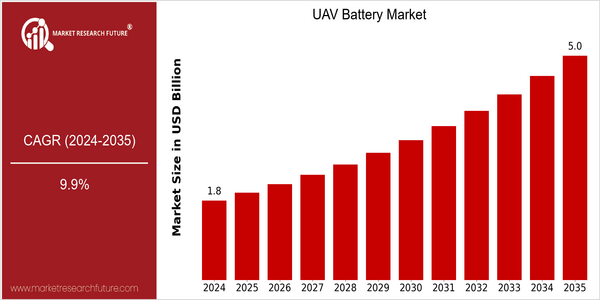
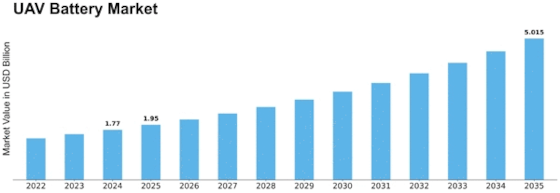

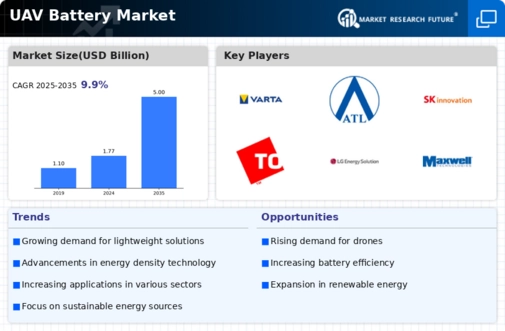
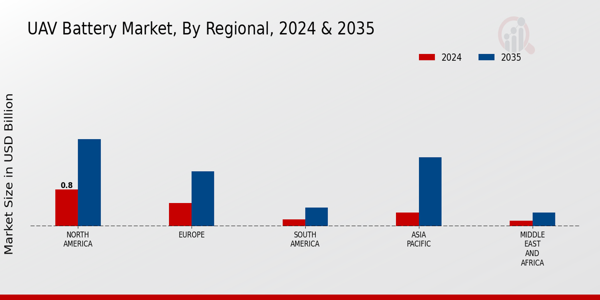
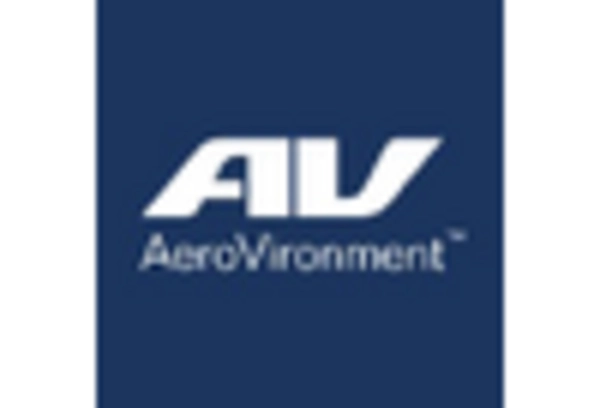
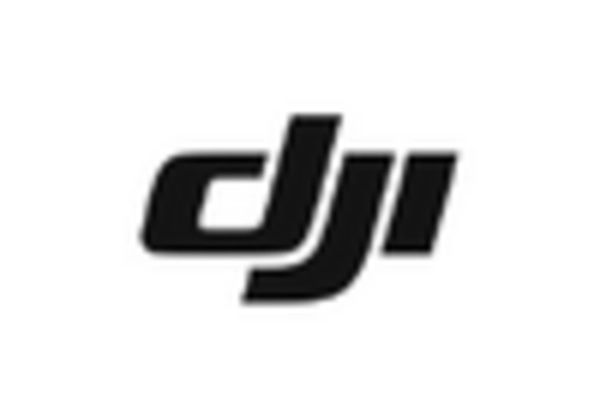

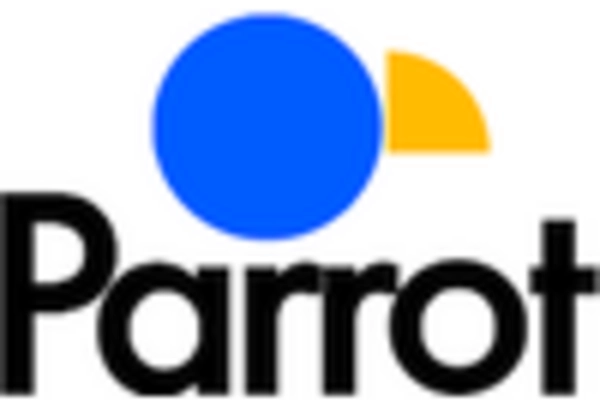
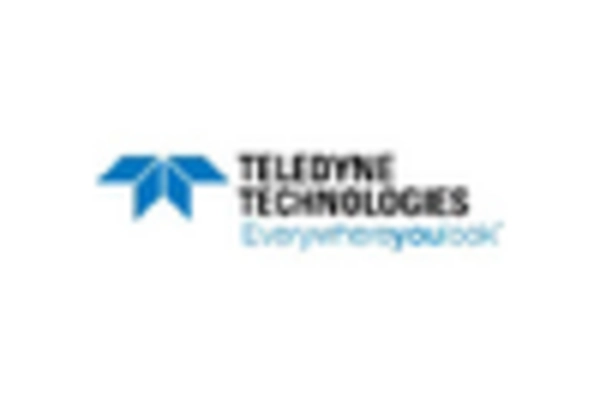
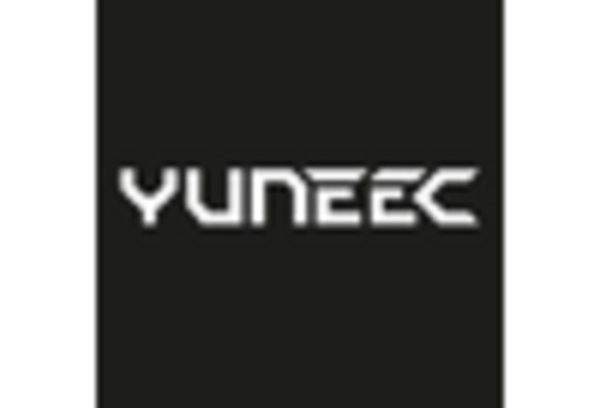

Leave a Comment